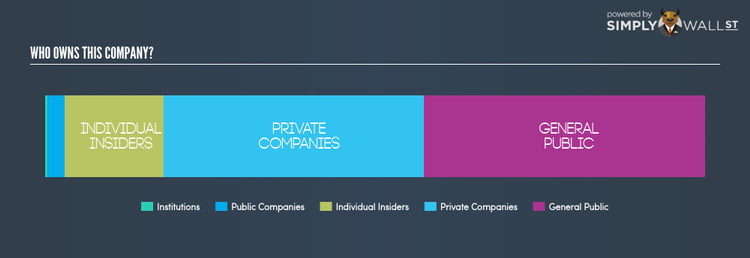Who Owns Abterra Ltd (SGX:L5I)?

In this article, I will take a quick look at Abterra Ltd’s (SGX:L5I) recent ownership structure – an unconventional investing subject, but an important one. Ownership structure has been found to have an impact on shareholder returns in both short- and long-term. Since the same amount of capital coming from an activist institution and a passive mutual fund has different implications on corporate governance, it is a useful exercise to deconstruct L5I’s shareholder registry.
View our latest analysis for Abterra
Institutional Ownership
Institutional investors transact in large blocks which can influence the momentum of stock prices, at least in the short-term, especially when there is a low level of public shares available on the market to trade. With hardly any institutional ownership, L5I stock poses limited concern relating to the effect institutional block trades have on its stock price.
Insider Ownership
Insiders form another group of important ownership types as they manage the company’s operations and decide the best use of capital. Insider ownership has been linked to better alignment between management and shareholders. 15.05% ownership of L5I insiders is large enough to make an impact on shareholder returns. In general, this level of insider ownership has negatively affected underperforming (consistently low PE ratio) companies and positively affected the companies that outperform (consistently high PE ratio). It may be interesting to take a look at what company insiders have been doing with their holdings lately. While insider buying is possibly a sign of a positive outlook for the company, selling doesn’t necessarily indicate a negative outlook as they may be selling to meet personal financial needs.
General Public Ownership
A big stake of 42.51% in L5I is held by the general public. This size of ownership gives retail investors collective power in deciding on major policy decisions such as executive compensation, appointment of directors and acquisitions of businesses. This level of ownership gives retail investors the power to sway key policy decisions such as board composition, executive compensation, and potential acquisitions. This is a positive sign for an investor who wants to be involved in key decision-making of the company.
Private Company Ownership
Another important group of owners for potential investors in L5I are private companies that hold a stake of 39.41% in L5I. These are companies that are mainly invested due to their strategic interests or are incentivized by reaping capital gains on investments their shareholdings. With this size of ownership in L5I, this ownership class can affect the company’s business strategy. As a result, potential investors should further explore the company’s business relations with these companies and find out if they can affect shareholder returns in the long-term.
Next Steps:
With a low level of institutional ownership, investors in L5I need not worry about non-fundamental factors such as ownership structure causing large impact on stock prices. However, ownership structure should not be the only determining factor when you’re building an investment thesis for L5I. Instead, you should be evaluating company-specific factors such as the intrinsic valuation, which is a key driver of Abterra’s share price. I highly recommend you to complete your research by taking a look at the following:
Financial Health: Is L5I’s operations financially sustainable? Balance sheets can be hard to analyze, which is why we’ve done it for you. Check out our financial health checks here.
Past Track Record: Has L5I been consistently performing well irrespective of the ups and downs in the market? Go into more detail in the past performance analysis and take a look at the free visual representations of L5I’s historicals for more clarity.
Other High-Performing Stocks: Are there other stocks that provide better prospects with proven track records? Explore our free list of these great stocks here.
NB: Figures in this article are calculated using data from the last twelve months, which refer to the 12-month period ending on the last date of the month the financial statement is dated. This may not be consistent with full year annual report figures.
To help readers see pass the short term volatility of the financial market, we aim to bring you a long-term focused research analysis purely driven by fundamental data. Note that our analysis does not factor in the latest price sensitive company announcements.
The author is an independent contributor and at the time of publication had no position in the stocks mentioned.

 Yahoo Finance
Yahoo Finance 
